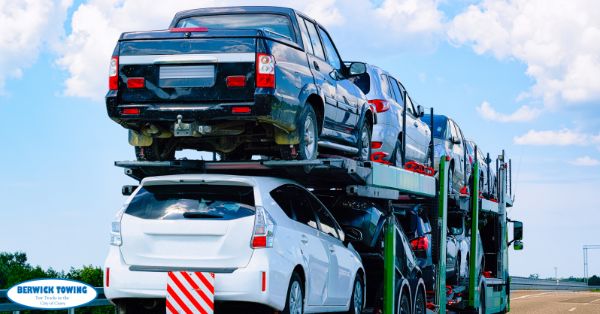The many types of vehicles on the road require more than a single transport solution. Cars, trucks, and even boats and planes all vary in size, weight, and dimension, placing unique demands on the transport company when it comes to careful, efficient handling. Flatbed trucks and car haulers are the customer’s two core options in getting their vehicle from A to B.
It’s therefore essential that the operation of and differences between these two basic models are highlighted to help customers appreciate why it’s a good idea to hire a transport company in the first place.
It also helps them understand key factors like service cost, benefits, and potential risks related to their vehicle’s journey. Here’s our comprehensive guide on choosing which truck design is best for your transportation needs based on their pros and cons.
The Importance of Vehicle Dimensions and Weight
Most vehicles can be loaded onboard a car hauler. By “most vehicles,” we’re referring to models like city cars, coupes, and sedans. Other types of vehicles will require heavy-duty towing. These heavy-duty models earn the title since they start at around the 25-ton range!
These greater weights require transport rigs with super-strong frames and powerful engines to deliver the necessary torque and horsepower. Here are some examples of the types of vehicles that require heavy-duty transportation:
- Semi-trucks
- Motor homes
- Buses
- Trailers
- Construction vehicles
- Unusually tall or wide vehicles
Heavy-duty cargo can usually be found on the back of a flatbed truck. Let’s start our top 5 tips by introducing a few examples of this type.
1. Subtypes of Transport Trucks
The best transport teams know there’s more to flatbeds than a single design. Here are three examples beyond the traditional flatbed, each better suited to different tasks:
-Step Deck
Step decks have two drops: One upper deck closest to the driver and one behind that sits lower to the ground. These are used when the cargo being transported exceeds the height limitations of a standard flatbed and can handle some very heavy cargo. Step decks can also supply a ramp for easy driving on and off.
-Removable Gooseneck (RGN)
This is a low-bed trailer type ideal for easy vehicle loading and unloading, thanks to its detachable front that helps transform the trailer into a ramp. It can also handle some hefty loads and vehicles of significant length. A stretch RGN is used for the latter (usually when a vehicle exceeds 29 feet).
-Double Drop
This type is also called a lowboy. This is because they sit closest to the ground of all the flatbed types. They’re essentially a combination of the previous two designs in that they can handle heavy and high cargo. Double drops have three decks to carry vehicles – two higher decks on either side of the central, lower deck.
This primer will help you recognize the various trucks and if the transport company knows the right design for your needs. Now let’s cover the pros and cons of the two main transport methods.
2. The Pros of Flatbed Trucks
Flatbeds are a good solution when customers have a single vehicle to transport. Flatbeds can handle more than one vehicle (sometimes up to four) but are particularly well-suited to heavy-duty vehicles. They are, therefore, frequently seen hauling steam rollers, diggers, and other construction equipment.
Flatbeds have a long, level surface that helps prevent roll-off and gives the vehicle plenty of room, especially if you’re only moving one. It’s exclusive in this regard and won’t expose the vehicle to being dripped on, scratched, or dented by other vehicles being carried above or beneath.
Flatbed trucks are best suited to shorter hauls, such as moving models from dealer to dealer. They’re also good for picking up damaged, inoperable, or stranded vehicles for transport to a mechanic or other relatively nearby location.
The use of a winch is more common with flatbeds and is beneficial if a vehicle has been so damaged that it can’t steer or roll onto a transport truck. Some flatbeds can lower their hydraulic frame a limited distance to the ground, which helps with winching vehicles on. Flatbeds have greater versatility than car haulers thanks to their smaller size, allowing them to access tighter spots like residential areas and navigate narrow winding roads.
Then there’s the advanced expertise level of flatbed drivers. A quality transport company hires only licensed and experienced staff who know how to carry the heavy-duty and oversized vehicles often loaded onto flatbeds. This requires above-average geospatial awareness that takes the height, weight, and other dimensions of transporting and maneuvering heavier vehicles into account.
3. The Cons of Flatbed Truck
The additional driving skills necessary to operate flatbeds is one factor that increases the overall cost of these services. Winching the vehicle onto the truck will also add to the expense, nor are flatbeds as readily available as car haulers. This means you’ll pay more to use one and will probably have to wait longer before a place becomes available. The silver lining is that you’ll probably get a faster delivery time since fewer vehicles will be onboard compared to car haulers.
The law of supply and demand could see some flatbed operators charging exceedingly high fees (particularly for rush transport) because they know their service is at a premium relative to car hauling. Another drawback is that flatbeds are a form of open transport. Vehicles in transit are exposed to the elements and potential damage from on-road debris like dirt and small stones. The risk of damage from these factors is relatively low yet should factor into your decision.
Not sold on flatbeds after reading about those drawbacks? Let’s take an honest look at car haulers and see how they can help and hinder smooth transportation.
4. The Pros of Car Haulers
These are the most common auto transport trucks. They’re readily available, which allows for their first benefit: car haulers are cheaper than flatbeds because transport companies must compete more fiercely for your business, knowing there’s no shortage of alternatives for you.
Car haulers are also cheaper because the overall cost of transit for the company is split between the many customers who have their vehicles onboard. This is sometimes up to 10 customers simultaneously. These trucks can be single or multi-level and are the go-to for long-distance transport like intrastate and interstate journeys. The definition of long distance differs; most companies will consider a journey of more than 50 miles as qualifying.
Haulers typically don’t need to use winches; however, in some cases, inoperable vehicles may require a winch. Some car haulers can provide one, while others can’t. Car haulers can also supply enclosed transport to protect against elemental exposure, on-road debris, and theft.
5. The Cons of Car Haulers
These much larger trucks lack the maneuverability of flatbeds, so their operational zones are limited – no squeezing into residential areas or along narrow winding roads with this one! This could create some inconvenience and added expense for the customer. The transport team’s potential inability to drop a vehicle off at an ideal spot could mean the customer having to meet the car hauler at a secondary location to pick their vehicle up.
Car haulers are not typically used for heavy-duty vehicles, which limits their use if you need bulkier models moved. Delivery time is likely to be slower due to the larger number of vehicles onboard, some of which must be delivered before yours. Some transport companies may favor you in the delivery order if you pay extra; however, this can be viewed as a drawback as well as a benefit.
Enclosed car hauling is more expensive than open style for two reasons: The customer is paying for extra protection, and the transport company has fewer customers to split the cost. Lastly, demand for enclosed hauling is lower than for open transport, further raising the price.
It is essential to hire an experienced and trustworthy transport company because of the many variables involved. It’s the only way to be sure of the right truck, the most responsible handling, and a final price that reflects only what’s necessary to get the job done safely and effectively.
Affordable Towing Services Company in Melbourne South Eastern Suburbs.
Berwick Towing & Transport located near the 29 Blaxland Dr, Dandenong North VIC 3175 Please check below map.
Berwick Towing & Transport
27B William Rd
Berwick VIC 3806
https://berwick-towing.com.au/
* Find us on Google Map

